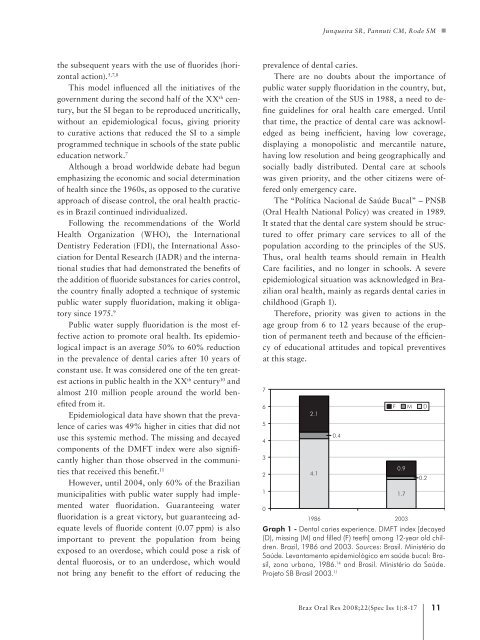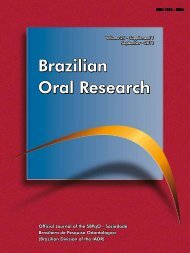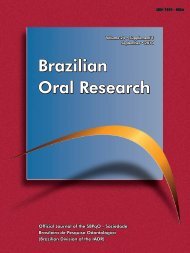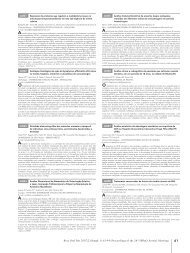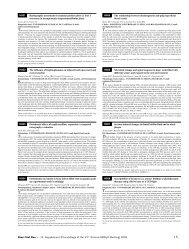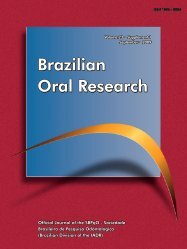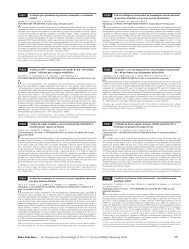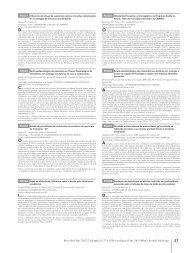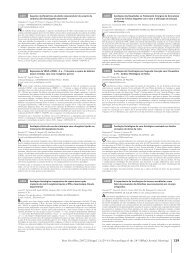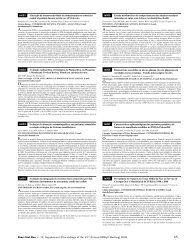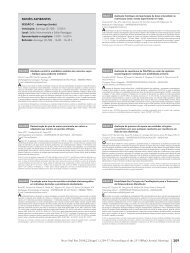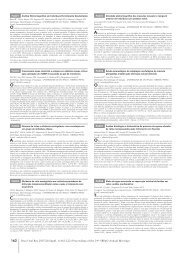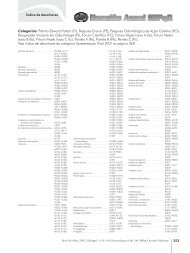Brazilian Oral Research Brazilian Oral Research Brazilian Oral
Brazilian Oral Research Brazilian Oral Research Brazilian Oral
Brazilian Oral Research Brazilian Oral Research Brazilian Oral
Create successful ePaper yourself
Turn your PDF publications into a flip-book with our unique Google optimized e-Paper software.
the subsequent years with the use of fluorides (horizontal<br />
action). 5,7,8<br />
This model influenced all the initiatives of the<br />
government during the second half of the XX th century,<br />
but the SI began to be reproduced uncritically,<br />
without an epidemiological focus, giving priority<br />
to curative actions that reduced the SI to a simple<br />
programmed technique in schools of the state public<br />
education network. 7<br />
Although a broad worldwide debate had begun<br />
emphasizing the economic and social determination<br />
of health since the 1960s, as opposed to the curative<br />
approach of disease control, the oral health practices<br />
in Brazil continued individualized.<br />
Following the recommendations of the World<br />
Health Organization (WHO), the International<br />
Dentistry Federation (FDI), the International Association<br />
for Dental <strong>Research</strong> (IADR) and the international<br />
studies that had demonstrated the benefits of<br />
the addition of fluoride substances for caries control,<br />
the country finally adopted a technique of systemic<br />
public water supply fluoridation, making it obligatory<br />
since 1975. 9<br />
Public water supply fluoridation is the most effective<br />
action to promote oral health. Its epidemiological<br />
impact is an average 50% to 60% reduction<br />
in the prevalence of dental caries after 10 years of<br />
constant use. It was considered one of the ten greatest<br />
actions in public health in the XX th century 10 and<br />
almost 210 million people around the world benefited<br />
from it.<br />
Epidemiological data have shown that the prevalence<br />
of caries was 49% higher in cities that did not<br />
use this systemic method. The missing and decayed<br />
components of the DMFT index were also significantly<br />
higher than those observed in the communities<br />
that received this benefit. 11<br />
However, until 2004, only 60% of the <strong>Brazilian</strong><br />
municipalities with public water supply had implemented<br />
water fluoridation. Guaranteeing water<br />
fluoridation is a great victory, but guaranteeing adequate<br />
levels of fluoride content (0.07 ppm) is also<br />
important to prevent the population from being<br />
exposed to an overdose, which could pose a risk of<br />
dental fluorosis, or to an underdose, which would<br />
not bring any benefit to the effort of reducing the<br />
Junqueira SR, Pannuti CM, Rode SM<br />
prevalence of dental caries.<br />
There are no doubts about the importance of<br />
public water supply fluoridation in the country, but,<br />
with the creation of the SUS in 1988, a need to define<br />
guidelines for oral health care emerged. Until<br />
that time, the practice of dental care was acknowledged<br />
as being inefficient, having low coverage,<br />
displaying a monopolistic and mercantile nature,<br />
having low resolution and being geographically and<br />
socially badly distributed. Dental care at schools<br />
was given priority, and the other citizens were offered<br />
only emergency care.<br />
The “Política Nacional de Saúde Bucal” – PNSB<br />
(<strong>Oral</strong> Health National Policy) was created in 1989.<br />
It stated that the dental care system should be structured<br />
to offer primary care services to all of the<br />
population according to the principles of the SUS.<br />
Thus, oral health teams should remain in Health<br />
Care facilities, and no longer in schools. A severe<br />
epidemiological situation was acknowledged in <strong>Brazilian</strong><br />
oral health, mainly as regards dental caries in<br />
childhood (Graph 1).<br />
Therefore, priority was given to actions in the<br />
age group from 6 to 12 years because of the eruption<br />
of permanent teeth and because of the efficiency<br />
of educational attitudes and topical preventives<br />
at this stage.<br />
7<br />
6<br />
5<br />
4<br />
3<br />
2<br />
1<br />
0<br />
2.1<br />
4.1<br />
0.4<br />
Graph 1 - Dental caries experience. DMFT index [decayed<br />
(D), missing (M) and filled (F) teeth] among 12-year old children.<br />
Brazil, 1986 and 2003. Sources: Brasil. Ministério da<br />
Saúde. Levantamento epidemiológico em saúde bucal: Brasil,<br />
zona urbana, 1986. 14 and Brasil. Ministério da Saúde.<br />
Projeto SB Brasil 2003. 11<br />
0.9<br />
1.7<br />
1986 2003<br />
F M D<br />
0.2<br />
Braz <strong>Oral</strong> Res 2008;22(Spec Iss 1):8-17 11


